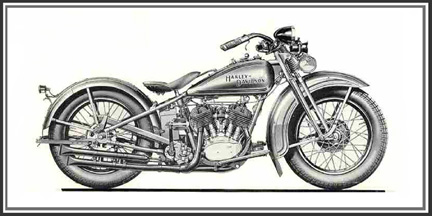
1930

1930 750cc Flathead
The 1930's saw more record breaking and award winning Harley-Davidson's. The sport model DLD was introduced which had higher compression, a larger carburetor and more horsepower. The smaller twin also got a new frame and front fork. A new larger 30.50 ci, (500cc flathead- Model C) single was introduced which shared the same frame as the 750cc twin and the smaller 350cc single. It came in a standard Olive Green with color options of Maroon, black, blue, gray and cream, had a top speed of around 60 mph with 10.4 horsepower at 3,600 rpm's with a total weight of 340 lbs.
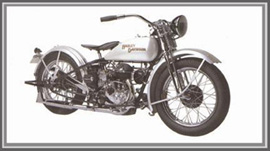
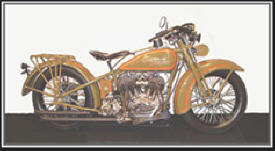
1930 Model C 1930 Model V 1200cc
Other models for 1930 were the Model 30C; a 30.5ci single, Model; 30D, 45ci SV Twin, Model; 30DL, 45ci, SV Twin, high compression, Model; 30DLD, 45ci, SV Special Sport Solo, Model 30V; 74ci, Big twin, and Model 30VL; 74ci, Big Twin, high compression. The VL flathead V-Twin, with a 74ci, (73,7ci) displacement, 3.44 x 4.0in bore and stroke, with a compression ratio of 4.5:1, produced 30 horse power at 4,000 rpm. The V and the higher compression VL models were still known as "seventy-fours", though they were a completely different motorcycle than the earlier FD and JD predecessors. The new flathead 74ci was first introduced in 1929, just a few months before the stock market crash. The VL's produced less than the 15 to 20 percent increase in horsepower as expected, had a less desirable clutch, flywheel, less than expected lubrication, and there was some problems with the new valve springs, requiring new parts to be made which had to be shipped to the dealers. Many of the die-hard JD and JDH fans from the previous years, were unpleased with the new V's. Overhauls were sometimes necessary only days after delivery. The replacement of valves, springs, and pistons became needed, and they started a crash redesign program during which time the bike was taken off the market for several, (around four), months. It then came back out with larger flywheels, and larger crankcases which they needed to accommodate them. This in turn led to a different frame. Basically, the V-series had to be almost completely broken down, dismantled, and then rebuilt. Many of the dealers weren't happy about this, because they were sent out to be fitted at the dealers expense. The effects of the depression was effecting the dealers as well as those who wanted to purchase motorcycles. Over 1,300 bikes had to be rebuilt.
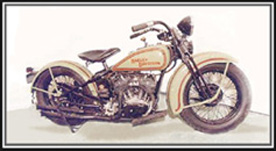

1930 VLD 1930 Side-Valve VL
The 1930 V provided 28 horsepower at 4,000rpm, and the VL produced 30 horsepower at 4,000rpm. Both 45 degree V-Twins, with 3 speed sliding gear transmissions, a 60 inch wheelbase with a 28 inch seat height. They used dry, multi-plate, metal lined discs, for clutches, duplex (oil-mist lubricated) chain for the primary drive, with a chain final drive, and leading-link Springer fork for the front, and rigid for the rear suspension. The fuel capacity of 4 gallons they got between 35-50 mpg for fuel consumption. They had a gallon oil capacity and a 6 volt-22amp battery The top speed for V's was around 80mph, and around 85 for the VL's with a weight of 529lbs. 3,246 VL's wee built and were sold for $340. Four versions of the new seventy-four were available in 1930. The V and the VL (which had batteries), and the VM and the VMLL (which magneto generators). With the introduction of the VL, the new Side-Valve Twin was still using the J's total loss lubrication system.
The J series had been around for years, and it's inlet-over-exhaust valve arrangement hailed back to the very first Harleys. Now Indians and Excelsiors were leaving Milwaukee twin for dead. Harley Davidson needed a new engine to compete. The big question was, should it go for side-valves, or overheads. Overhead valves was the coming technology: it allowed engines to rev higher and harder, and in the leading edge, British bikes were using it. But Harley-Davidson took what seems like a retrograde step: it went for side-valves. There were actually good reasons for doing so. At the time, overhead valves were still exposed to the open air, so they were noisy, messy, oily things that lubricated one's trousers and didn't suit Harley-Davidson's sensible touring image. They wore out quickly, and if a valve dropped (not unknown), mechanical chaos ensued. Side-valves, on the other hand, were quieter and enclosed. The engines were cheaper to make and, with detachable cylinder heads, easier to repair than the inlet-over-exhaust set-up, while the decoking ritual became a Sunday morning pleasure. But the Indian Scout 61 and 74ci (1000 and 1200cc) Chiefs, were all using side-valves and were proving to be quicker than the Harleys. The side-cars and servi-cars, all had interchangeable wheels now, and the sidecar had a brake that was integrated with the motorcycles stoppers. A forged I beam front fork replaced the tube style model of the J model and new 19 x 4 inch tires came standard with 19 x 4.4 inch at an additional cost.

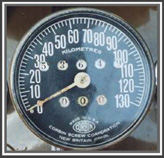
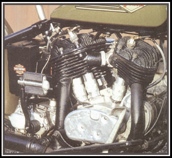
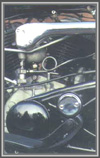
There were other improvements over the "J". The duplex primary chain had a metered oil supply and the engine was easier to maintain than before. The V could keep up 70-75mph (113-121km/h). It may have been heavy, but the VL was capable of a genuine 85mph (137km/h). V had other advantages. The new primary chain was stronger than the old one and it had an automatic metered lubrication; both wheels were at once quickly detachable and interchangeable. The seat height was comfortably low; and the electrics maintained Harley-Davidson's good reputation in this area, with a 22-amp battery, sealed coil and high frequency horn. One could choose between either generator or magneto (in which case it was a VM or VLM respectfully) and there was a package truck option as well as the usual sidecar version. In Japan, they built up a sort of forerunner to the servi-car, by ordering VL's from Milwaukee with extra long rear chains and no rear wheels. The V models valves each had their own cam, just like the 45's, and the coil ignition system was better sealed against external elements, but with the effects of he depression, a lot of people couldn't afford a motorcycle.
Despite all it's problems, Harley Davidson managed to sell over 10,000 bikes in 1930. The trouble was, just as the V seemed to finding it's feet, the depression began to take hold. Although the bike was launched only a couple of months before the Wall Street Crash, with a third of the working population out of work, less than 7,000 bikes were sold and 3,700 the year after. During the depression, the motorcycle became more of a luxury item, as people were more concerned with keeping roofs over their heads, and food in their stomachs. The Harley-Davidson Company, as bad as times were during the depression, the "four-fathers" discussed giving up, But the company kept working at just 10 per cent of its capacity. In the end, they decided to economize rather than close down, as was discussed. The industrial engine business was abandoned, men were laid off and salaries were cut while the racing effort was curtailed all together. At one board meeting, the four founders considered giving up. The Milwaukee complex they had worked so hard to build up was working at 10 percent capacity. They decided to economize instead of close down: the industrial business was abandoned, men were laid off and salaries were cut while the racing effort was curtailed all together, but after a few years, riders saw that the V bikes had evolved into another reliable touring bikes just like the Js had been with a production total of 17,422 motorcycles for 1930.

1931 45ci Flathead
In 1931, production had dropped to the lowest figure in 20 years as the full effects of the Depression were felt, but the concerted effort to freshen up the V series went on. A new oval style tool box replaced the canister type of previous years, and a disc type bell-mouth Klaxon horn with a chromed grill was added. Shorter solo handlebars were also an option at no additional cost, a ride-control knob which adjusted suspension, (behind the headlight), was added, and the double muffler system exhaust was replaced by a single one. The Model 31C; 30.5ci single, Model 31D; 45ci, SV V-twin, Model 31V; 74ci, Big Twin, Model 31DL; 45ci, SV V-Twin, high compression, Model 31DLD; 45ci, SV Special Sport Solo, Model 31V; 74ci, Big Twin, Model 31VC; 74ci, Big Twin Commercial, and Model 31VL; 74ci, Big Twin, high compression, were the models offered for 1931 with a production total of 10,500 motorcycles. The 500cc single, (which came to be known as the "thirty-five") was the only single set for 1931. A new Schebler carburetor with a die cast unit and a timing plug was fitted to the crankcase for ignition adjustment, The side-cars and servi-cars, which had remained unchanged for the last ten years got a new 3 speed transmission with a reverse gear for their uses.


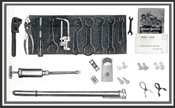
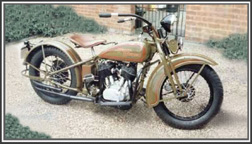
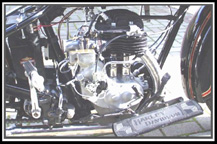
1931 Flathead V-Twin 1931 C Model Single
1932
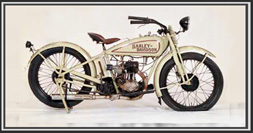
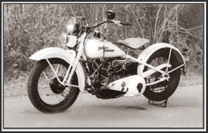
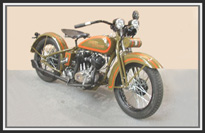
1932 Single 1932 V 1932 VL 1200cc
In 1932, the 45cubic inch, three wheel servi-car started it's 41 year run as a commercial and police vehicle and Harley Davidson was making acing history both overseas and in the U.S. as well as winning in Hill-Climb competitions. The front forks, and transmissions were made stronger and more durable and the cylinders were redesigned to provide more cooling air to the exhaust port in 1932
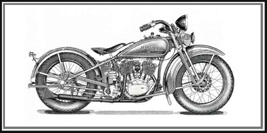

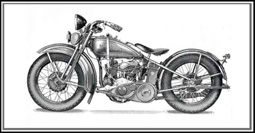
1932 750cc V-Twin 1932 Twin with Sidecar 1932 750cc V-Twin
More AMA Grand National Championship wins were accomplished 1932 as well as a National Hill-Climb Championships.

1932 DAH Hill-Climber
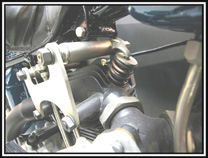
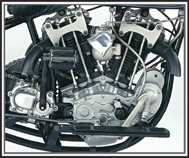
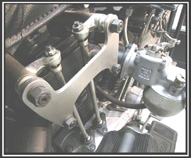
1932 DAH Valves 1932 DAH Engine 1932 DAH Pushrods
Models offered for the year were, Model 32C; 30.5ci, single, Model 32R; 45ci, SV V-Twin, Model 32RL; 45ci, SV V-Twin, high compression, Model 32RLR; 45ci, SV V-Twin, Special Sport Solo, Model 32V; 74ci, Big Twin, and Model 32VL; 74ci, Big Twin, high compression, with a production of 6,841 motorcycles. 1932 - The cost of the 45ci Servicar introduced in 1932 was $450
1933
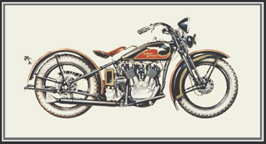
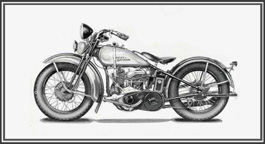
1933 74ci Big-Twin 1933 45ci 750cc
The VLD, a 36hp machine that finally matched the performance of the two cam JDH that was introduced in 1933. It's secret was magnesium alloy pistons, which, together with new cylinders and heads, gave a compression ratio of 5:1. Perhaps even more significant was that buyers now had a choice of colors, where, before, they were grey, and after the First World War, they were olive green (with some pin-stripping, if one was so lucky). The VLD Sport Solo was also introduced for 1933, with aluminum alloy pistons, (replacing the magnesium alloy ones on the previous models), new cylinder heads, which had a new "Y" shaped intake manifold which gave the fuel a more direct hit to the carburetors, with a compression ratio of 5:1, and 36 horsepower at 4,5000 rpm. The V series got an improved oil pump, new generator, a stronger fork, and new cylinders which were designed for better dissipation of heat. The 45's , (which were now called the "R" series), also got the same upgrades as did the Thirty-Fives Singles.


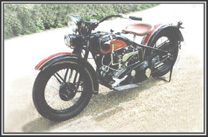
In 1933, an art-deco "eagle" design was painted on the tanks which marked the beginning of this as a graphic design for Harley-Davidson motorcycles, (previously order-only paint schemes). There were low sales numbers with the Great Depression, and the factory cut back to a two-day work week to avoid lay-offs. Production dropped to 3,700 motorcycles this year.
The small twins also got a stronger frame, better valve springs, a new 4-plate clutch, and larger flywheels. Models offered this year were, Model 33C; 30.5ci, single, Model 33R; 45ci, SV, V-Twin, Model 33RL; 45ci, SV V-Twin, high compression, Model 33RLR; 45ci, SV V-Twin, Special Sport Solo, Model 33V; 74ci, Big Twin, Model 33VL; 74ci, Big Twin, high compression, Model 33VLD; 74ci, Big Twin, Y manifold, with a production of 3,703 motorcycles.
The choice of colors for those who bought a new Harley were between silver and turquoise with black and gold stripping, black and mandarin red with gold stripping, sunshine blue and white (more gold stripping), or police blue and white, again with gold highlights. Olive green still lurked in the background, but only complimented by brilliant green and matching pin-strips. The whole colorful ensemble was set off by art deco bird motif, perhaps the most stylish design ever to grace a Harley-Davidson tank.
1934 V
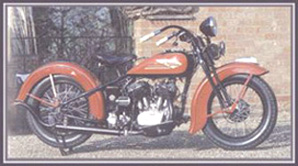

In 1934 the V and R series were fitted with a new longer High-flo muffler, with an upswept exhaust tips replacing the fishtail tips, and flared, skirted, rear fenders were added with a new Airflow type taillight. Some of the newer paint schemes were only available by special order, and a decorative chrome package which could be added for an additional $15.The chrome package included chromed headlights, handlebars, chain guard, a generator cover, and exhaust pipes.
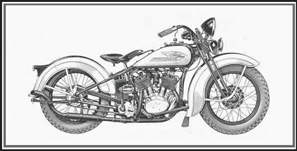
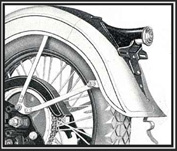
1934 45ci 750cc
A larger better contoured seat made of black leather was an added option and a "buddy seat" which sat on the rear fender could be added for a second passenger also. The toolbox was changed to a box that was mounted to the frame behind the transmission, and the choice of either 18 or 19 inch wheels was available.
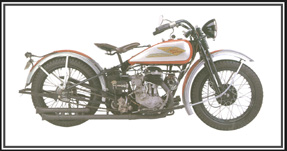
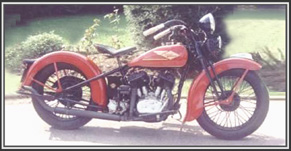
1934CB Single 1934 V
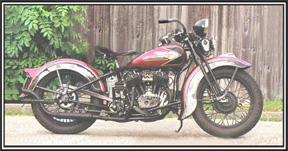

1934 RL 1934 VLD
Model 34B; 21ci, SV single, Model 34C; 30.5ci, SV single, Model 34CB; B model with 30.5ci motor, Model 34R; 45ci, SV V-Twin, low compression, Model 34RL; 45ci, SV V-Twin, high compression, Model 34RLD; 45ci, SV V-Twin, Special Sport Solo, Model 34VD; 74ci, solo, low compression, Model 34VDS; 74ci, SV V-Twin, low compression, sidecar gears, TNT motor, Model 34VL; 74ci, Big Twin, high compression, Model 34VFDS; 74ci, SV V-Twin, heavy duty commercial TNT motor, Model 34VLD; 74ci, SV V-Twin, Special Sport Solo, TNT motor, were models also offered for 1934 with a production of 10, 231 motorcycles. An 80 cubic inch, (1340cc) Twin was introduced late in the year designated as the VLDD.
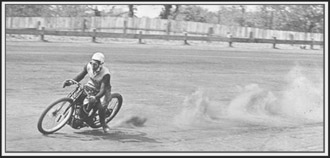
1935 saw winning races for Harley Davidson, with their "Peashooter" winning all thirteen of the American Motorcycle Association National Championship dirt track races including the breaking of four records.
As the earlier V's (flatheads), were gradually updated, 1935 saw an optional four-speed transmission and a new 80ci (1300cc) version. The Eighty was really no more than an existing Seventy-Four, bored out for extra capacity and 39hp in high compression form. The Eighty was a response to the Police Department for more power. It was no sportster; that role was reserved for the imminent ohv Knucklehead. Instead, it continued the Harley tradition of solid, reliable tourers. It also underlined Harley-Davidson's fondness for engine sizes-54, 61,74 and 80ci (883, 1000, 1200 and 1300cc) versions that are well established. These machines came out of Milwaukee until 1951, the engines were produced until 1974. Throughout their career, the "Flatheads: probably won more races than any other engine. The R series got internal expanding rear brakes with both shoes as well as drums, hardened for better breaking and durability. The smaller twins got the same upgrades as the larger models, including a constant mesh transmission.

The four founders inspect the upcoming Knucklehead in progress before it's release in 1936
Other models for the year, were, Model 35R; 45ci, SV V-Twin, low compression, Model 35RL; 45ci, SV V-Twin, high compression, Model 35RLD; 45ci, SV V-Twin, Special Sport Solo, Model 35RLS; 5ci, SV V-Twin, low compression, sidecar gears, Model 35VD; 74ci, SV V-Twin, solo, low compression, Model 35VL; 74ci, Big Twin, high compression, Model 35VLD; 74ci, SV V-Twin, Special Sport Solo, Model 35VLH; 80ci, SV Twin, sport solo, with a production of 10, 368 motorcycles. Four different color combinations were offered for the 1935 twins, including Verdant Green and Black, Teak Red and Silver, Olive Green and Black, Egyptian Ivory/Regent Brown, and Venetian Blue and Silver.
1936
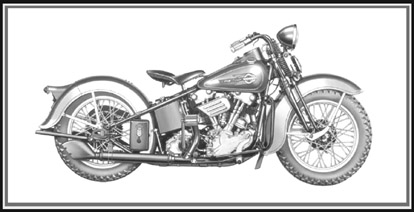
1936 Knucklehead
After the side valve V's, in 1936 Harley-Davidson wasted no time building momentum out of the depression, introducing its EL model, featuring the 61 ci (1000cc) overhead valve engine, also known as the "Knucklehead." The "Knuckleheads", named so because of the top of the engine having two knuckle looking heads on them. This engine, termed the "61 OHV" in factory literature and called the Sixty-one in every day circles was a mid-season 1936 model. This, in the opinion of many, is the motorcycle that saved Harley-Davidson. At that time, for the first time, a major American motorcycle company was building a big motorcycle with overhead valves (this coming shortly after the major engineering difficulties of the 1929 Forty-five and the 1930 Seventy-four). Also introduced this year was an 80 cubic inch side valve V-twin engine. Despite the depression Harley-Davidson produced almost 10,000 motorcycles in 1936. The Knucklehead was scheduled to appear in 1935, but production was slowed by the depression in spite of the depression and the financial risks involved with it's production.
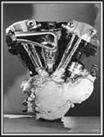

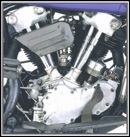
Five years in the making, built from the ground up, the model E, "Knucklehead" was launched in a very low-key, but in spite of Harley's stress to have it released as a limited production not intended for mass consumption, it was a roaring success. The old side-valve design was replaced with the first overhead valves to appear on a production Harley twin, operated by pushrods from a single, multi-lobed camshaft. The valves were set at right angles to each other, (an idea taken from aircraft engines), and a re-circulating oil system with a dry sump was used. The new motor was coupled to a four speed gearbox with a chain primary drive. The result being a simple yet reliable motorcycle which produced a claimed 37 horsepower in the base model E, and a 40 horsepower in the higher compression model EL.
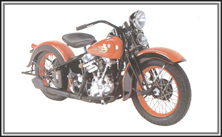
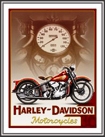
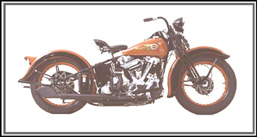
1936 Model EL - Knucklehead
A double down-tube frame was needed to handle the extra power, and the frame were strengthened again for 1937. The 18 inch wheels had 4.50 inch tires, the front fork used a more streamline and stylish oval tube struts, and the seat height dropped down to 26 inches, (which was lower than the Thirty-Five singles of a few years earlier). The hemispherical combustion chambers provided by valves set at 90 degrees meant the higher horse-powers in the standard E and high compression model EL. The single camshaft was quieter and more efficient than it's two and four shaft flatheads and with it's strong and powerful profile, riders said it was the best looking motorcycle they had ever seen. Weighting close to 600 pounds there was plenty of power to reach speeds of up to 100 mph.



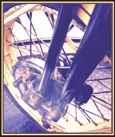

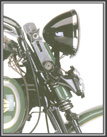
.Rims on most models matched the color of the secondary color, (like with a Teak Red and Black color scheme, the rims were painted red). The art deco comet tank emblem was used from 1936 through 1939, which remains one of the most popular and better known graphics for these motorcycles. 1936 was the only year for the 100mph first "standard" equipment Harley-Davidson speedometer unit, in 1937 a 120mph speedometer dial came. The ride control knob was still on the right which was moved two years later to the opposite side, where it could be adjusted while riding. The knucklehead sold 1.900 it's first year.
Models for the year included: Model 36E; 62ci, OHV Twin, medium compression, Model 36EL; 62ci, OHV Twin, special sport solo, Model 36ES; 61ci, OHV Twin, medium compression, sidecar gears, Model 36R; 45ci, SV Twin, low compression, solo bars, Model 36RL; 45ci, SV Twin, sport solo, high compression, solo bars, Model 36RLD; 45ci, SV Twin, sport solo, extra high compression, solo bars, Model 36RLDR; 45ci, SV Twin, competition special, Model 36RS; 45ci, SV Twin, low compression, sidecar gears, Model 36VD; 74ci, SV Twin, solo, low compression, Model 36VDS; 74ci, SV Twin, solo, low compression, sidecar gears, Model 36VHS; 80ci, low compression, sidecar gears, Model 36VL; 74ci, Big Twin, high compression, Model 36VLD; 74ci, SV Twin, Special sport solo, Model 36VLH; 80ci, SV Twin sport solo, with a production of 9,812 motorcycles. The 60.33ci, 3.31 x 3.5in bore and stroke OHV 45 degree Twin "knucklehead" came in Sherwood Green/Black, Dusk Gray/Buff, Venetian Blue/Croyclon Cream, and Maroon/Nile green for colors. The addition of factory options as a premium package that was started in 1934 offered a safety guard, (crash bars), lighted speedometer, a jiffy stand, Ride control, a chrome plate group, a steering damper, stop light and fender lamp, a dice shift knob, switch keys, saddlebags and hangers as the premium package for 1936 for an added $49.50 and a four speed transmission could be added to the 74ci or 80ci for an additional $15. Sherwood Green and Silver with standard silver rims was offered as a color scheme this year and the optional speedometers were equipped with a maximum speed hand, (a separate indicator that stayed fixed at the highest speed gained on the ride. A front fork cover was featured on the big twins for this year, but remained on the forty-fives for four years. The new cylinders for the VLH, (80ci), and the VLD, (74ci), had larger cooling fins for cooling. Because of the depression, with most other motorcycle companies folding and going out of business, Indian and Harley-Davidson were the only two major motorcycle companies that were still making motorcycles.
1937


1937 UL Flathead 1937 UH 80ci Flathead
In 1937, the V series became the U series because of it's modifications and the 45ci R series became the W series. The U models got a twin down-tube frame, a four speed transmission, and a re-circulating oil system as a standard package. The W models also got dry-sump lubrication and all the big twins shared the same strengthened frame. The big twin flatheads got had new cylinders with added fining and improved bearings and oil seals in the transmission. The improvements seen on the 61ci OHV were part of the new models for 1937, and the seventy-fours now had the same stroke as the 80, with the bore reduced to match the 61 OHV allowing both motorcycles to use the same pistons. The oil tanks on all models were painted the same color as the tanks and fenders for 1937.
Harley-Davidson had no qualms about capitalizing on their success both in racing and their production of their new motorcycle's engine capabilities with their new knucklehead. In March of 1937, Joe Patrali set a new top speed record of 136mph at Daytona Beach and beat the mark set by Indian at California's Muroc Dry Lake. Fred Ham set a new 24 hour record on the Knucklehead, riding over 1,825 miles at an average speed of 76 mph, establishing the Knucklehead's engine capabilities. The depression was starting to lift as Harley's new motorcycle came out and gained the attention and notoriety among American motorcyclists with their new motorcycle. Other than a change of image, it added class and performance to their standard of reliability. Sometimes referred to as the first "sportster", (before the sportsters came along), it took Harley Davidson back into competition. It wasn't just that the knucklehead was fast, it also had better looks than previous models. The key point being overhead valves, which allowed the engine to rev higher and produce more power than any previous road going V-Twin from Milwaukee, Harley Davidson was now ahead of its competitors.
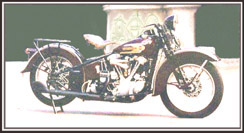
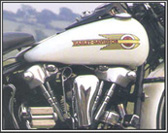
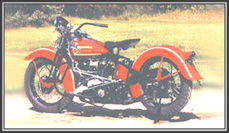
The new Knucklehead soon overshadowed, in a sense, the earlier side-valve bikes with knucklehead styling and a dry sump lubrication. The latter in particular was a big step forward from the prehistoric total loss system-riders had to get used to changing the oil every now and then, but at least it was circulating properly. The bikes got a new name, the U-series (Harley-Davidson never gave its bikes names in those pre-war years, hence the profusion of nicknames). The basic U was the low compression 74 and the UL was the same bike with 5.5:1 compression, while the equivalent 80s were designated UH and ULH, and Harley Davidson's electronics were more reliable than most.
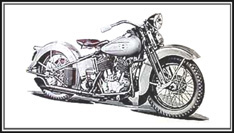
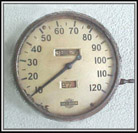
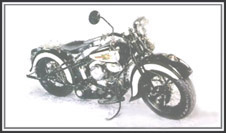
.These changes marked a final era of respectability for the big side-valvers. It was somehow symbolic that William Connelly and Fred Dauria had attempted a transcontinental record on VL's. They were sidelined by breakdowns, but they succeeded the following year when their U model and sidecar held together for the 30,000 mile crossing. The outfit wasn't promising-weighed down by a mountain of spare parts, its top speed was just 58mph (93km/h). Fred and William started late in the year, so they had to cope with freezing weather over the Rocky Mountain passes. They would ride for 300 miles (483km) each and stop for fuel every 600 miles (966km). After a total of 69 hours and 46 minutes, they rode triumphantly into Los Angeles, setting a record which was to stand for twenty years. Harley-Davidson's troublesome side-valve had come good at last. The gauges, (other than speedometer), were gone by 1938.


In April of 1937, William A. Davidson, vice president and eldest brother dies at the age of sixty-six after a protracted illness.
1938

1938 U
The big twins were reinforced again in 1938. Frames, brakes, clutches and transmissions were strengthened and the 74ci U model became the most popular model for commercial use and sidecars, C Class racing became a dominant racing category, and accessory groups became standard equipment on many models. Clutch assemblies were improved and the lower steering head cone with a self-aligning feature was designed to distribute force evenly on the bearings and the oil fitting was moved from the bottom to the rear of the oil tank.

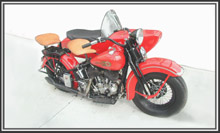

1938 U 1938 UL - Sidecar 1938 UL
More attention was given to the smaller twin as the problems with the bigger twins got sorted out resulting with the decision to build a sportier 750cc to compete with Indian. The new oil pump was upgraded, the transmission got a new shift mechanism with stronger gears, cooling fins were added to the timing case cover and the left side of the crankcase, and standard automotive grease fittings were added.
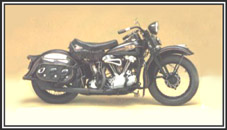
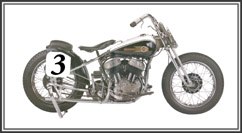
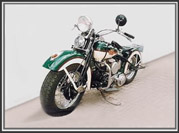
1938 61ci OHV 1938 WLDR 1938 WL 750cc
Customers could choose between either a standard or a deluxe accessory group in 1938. The standard accessory group was $16.70 and the Deluxe $49.75 with added Ride-Control, four-ply tires, and air cleaner, colored shift knob, saddlebags and chrome package. "little king" spotlights for $11.50, and "little beauty" spotlights for an additional $13.25 were also offered for the night riders preference. The gauges were gone on the speedometer consoles by this year, and the flathead had new cylinders with added fining, and improved bearings and oil seals in the transmission. The oil tanks were painted the same color as the tank and fenders on all models this year, (later to be painted black in the succeeding years).
Their WLDR, which rated at 27 horsepower was the model used for racing competition this year. The lights, and unnecessary equipment was removed by the riders for the competitions but could be left on for riding to the track or other riding, as the growth of amateur racing continued to grow, configured as a standard road model though with higher compression and larger valves, using roller bearings throughout the engine. The horsepower was beefed up to the mid thirties in 1939, and a factory built version built just for reason was built in another two years.
Colors offered for the WLDR model were: Teak Red with Black, Venetian Blue with White, Hollywood Green with Gold, and Silver Tan with Blue. A new beauty and appearance was a sales brochure slogan for 1938 with the different color schemes pin-stripping centered on the sides of the tanks and fenders, the ammeter and oil gauges were replaced with red and green lights, the bronze-brown hue was now gone, and the aid low-speed handling, higher handlebars were added The Daytona 22 was won on a WLDR in 1938. 139 WLDR's were built, which sold for $380.
1939


1939 EL 1939 Flathead
The 61 OHV Knucklehead was improved in 1939 with splined pinion and oil pump gears, and a one piece pinion shaft. The instrument panel was streamlined and color matched with the motorcycle itself. The fender light was included in the standard package, and the airflow tail light was replaced by a larger lamp with a license plate bracket above it. Larger valves springs were also fitted, and the third years price for the Knucklehead was $435.
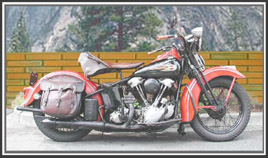
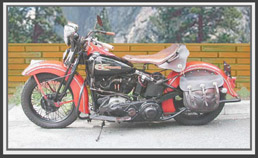
1939 EL
All the Harley-Davidson Big-Twins now had self aligning steering head bearings, and stainless steal pipes were added along with painted fender stripes. The instrument panel acquired the nick name of "the Cat's Eye". Teak Red and Black was still a primary color scheme for 139, but with a new arraignment of the fenders being of the basic color instead of two-tone. The Knucklehead got a new intake manifold along with the larger valve springs, and softer fork springs, and the fender light was included in the standard accessory package.
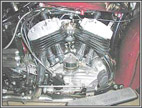
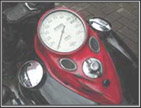
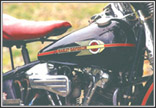
The Daytona 200 was won again this year by Harley-Davidson, but with a factory racer.
Author: Dermage,/Wm.R.G./Webmaster: wm.grett@yahoo.com